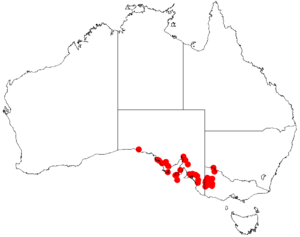Acacia dictyocarpa facts for kids
Quick facts for kids Acacia dictyocarpa |
|
|---|---|
| Scientific classification | |
| Genus: |
Acacia
|
| Species: |
dictyocarpa
|
 |
|
| Occurrence data from AVH | |
Acacia dictyocarpa is a type of shrub, also known as a wattle. It belongs to the Acacia family. This plant is special because it only grows naturally in southeastern Australia.
Contents
What Does Acacia dictyocarpa Look Like?
This rounded shrub usually grows between 1 and 3 meters (about 3 to 10 feet) tall. Its branches have tiny hairs that lie flat against the surface. The new shoots are often golden and hairy.
Like most wattle plants, Acacia dictyocarpa does not have true leaves. Instead, it has what are called phyllodes. These phyllodes are like flattened leaf stems that do the job of leaves. They are often shaped like a stretched oval, from 1.3 to 3 centimeters long and 4 to 12 millimeters wide. When they are young, they are very hairy, but as they get older, they lose some of their hair.
The phyllodes are grey-green in color. They have a rounded or slightly pointed tip. You can see one main vein, but the other smaller veins are hard to spot.
Flowers and Seeds
This wattle blooms in winter and spring, usually from July to October. It produces groups of flowers called inflorescences. Each group has one to five round flower-heads. These flower-heads are full of 15 to 30 golden-colored flowers.
After the flowers bloom, thin, long, and narrow seed pods grow. These pods are often squeezed in between where the seeds are. The pods are smooth and can be dark brown or black. They sometimes have a light white powder on them. Inside, the seeds are shiny brown to black and are about 4 to 5.5 millimeters long. They have small dots near their center.
Who Named This Plant?
The plant was first officially described by a botanist named George Bentham in 1855. He wrote about it in a scientific paper called Plantae Muellerianae: Mimoseae. This paper was published in a journal for botany.
Where Does Acacia dictyocarpa Grow?
You can find Acacia dictyocarpa in the northwestern parts of Victoria. Its home also stretches into the eastern parts of South Australia. It likes to grow in sandy or loamy soils. You'll often see it in areas with mallee trees or open woodlands.
In Victoria, it is scattered throughout the Mallee and Wimmera regions. In South Australia, it is found along the southern coast. Its range extends to places like Yalata, which is northwest of the Eyre Peninsula.

